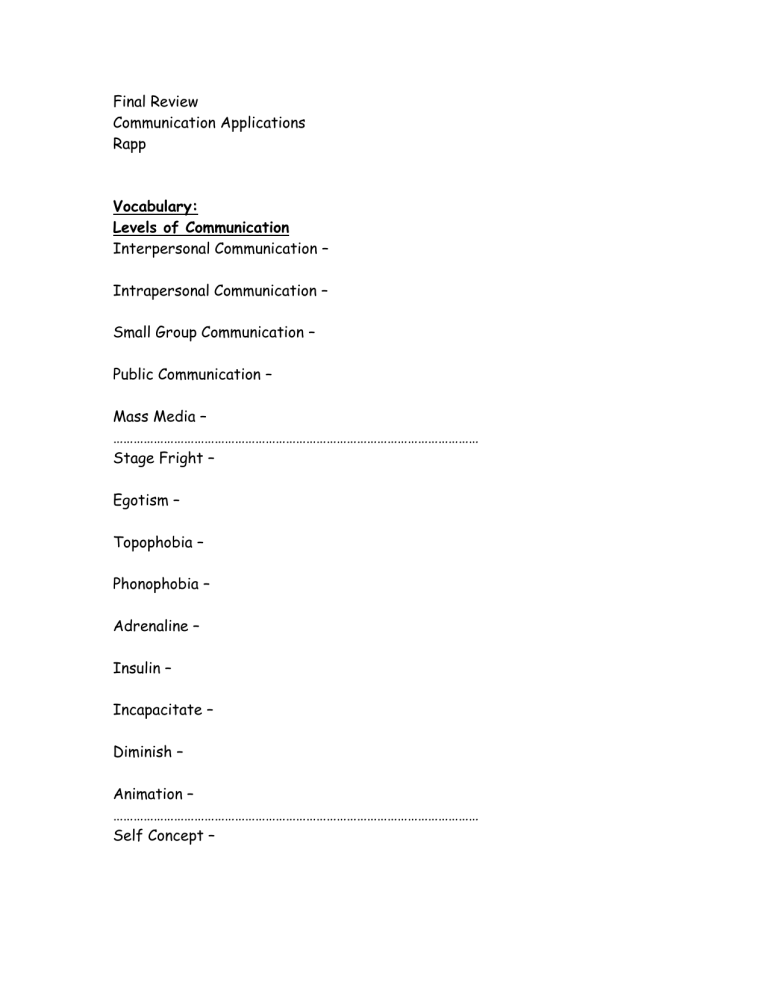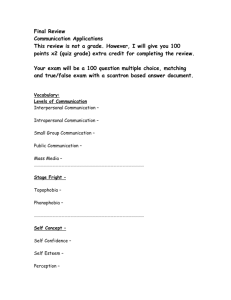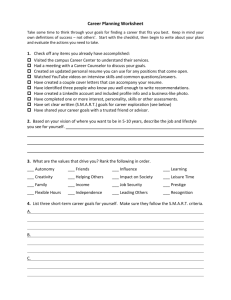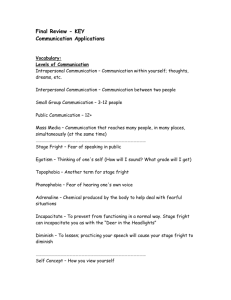Final Review CA

Final Review
Communication Applications
Rapp
Vocabulary:
Levels of Communication
Interpersonal Communication –
Intrapersonal Communication –
Small Group Communication –
Public Communication –
Mass Media –
………………………………………………………………………………………………
Stage Fright –
Egotism –
Topophobia –
Phonophobia –
Adrenaline –
Insulin –
Incapacitate –
Diminish –
Animation –
………………………………………………………………………………………………
Self Concept –
Self Confidence –
Self Esteem –
Perception –
Namecalling –
Stereotyping –
Sender –
Message –
Receiver –
Feedback –
Interference –
Context –
Channel -
Verbal -
Vocal –
Non Verbal –
C-O-M –
Psychological Interference –
Physiological Interference –
Physical Interference -
Non Verbal Communication –
Paralanguage –
Listening –
Hearing –
Appreciative Listening –
Discriminative Listening –
Comprehensive Listening –
Therapeutic Listening –
Critical Listening –
55% -
38% -
7% -
Kinesics -
Haptics –
Affect Displays –
Artifactuals –
Proxemics –
Four Primary Distance Zones
Intimate zone –
Personal zone –
Social zone –
Public zone –
Chronemics –
Tone of Voice –
Stereotype –
Interview –
Resume –
References –
Behavioral Questions –
Personal Questions –
Qualifier Questions –
Packaging –
Responsiveness –
Experience –
Miscellaneous –
Cover Letter –
Follow Up Letter –
Hamburger Method of Speaking –
Attention Getter –
Startling Statement –
Illustration –
Hypothetical –
Factual –
Rhetorical Question –
Quote –
Action –
Bridge –
Thesis Statement –
Signpost –
Main Points –
Support –
Summary –
Frame –
Tagging –
Fillers –
Disclaimers –
P to the Fifth –
Informative –
Persuasive –
Entertain –
Extemporaneous –
Memorized –
Manuscript Reading –
Impromptu -
Questions for Review
1.
The prefix c-o-m means:
2.
What must occur for successful communication to take place?
3.
Dyadic means:
4.
Communication between 2 people is what level of communication?
5.
At what level of communication can majority and minority opinions begin to form?
6.
At what level of communication does the feedback become mostly non-verbal?
7.
What percentage of what we communicate is nonverbal?
8.
What percentage of what we communicate is tone of voice?
9.
What percentage of what we communicate are the actual words?
10.
How long does it take to make a first impression?
11.
What does it take to correct a bad first impression?
12.
What is small group size? Ideal group size?
13.
At what level of communication does self awareness and self concept occur?
14.
At what level of communication does the feedback become mostly non verbal?
15.
The feedback is primarily delayed at what level?
16.
Give an example/application of each of the levels of communication:
Intrapersonal –
Interpersonal –
Small Group –
Public –
Mass Media –
17.
Explain “Butterflies in the Stomach” –
18.
How is Stage Fright nature’s way of helping you face a challenge?
19.
What is eye contact? What messages can eye contact, or the lack of, say to others?
20.
Describe a good handshake and explain the message your handshake says to others:
21.
Name and define the three theories of how self concept is formed:
22.
Explain the “Circles of Influence” concept:
23.
List some common stereotypes/molds in our society:
24. Draw a pie graph that represents the percentages in the messages we send:
25. List the Seven Deadly Habits of Bad Listening:
26. Describe the SOLER Listening Technique and how it works:
27. What is the difference between hearing and listening?
28. Draw and Label the Communication Cycle:
29. What are emotional filters and how do they affect listening?
30. Explain the Rate Gap:
31. List the different types of listening and be able to define them.
32. What percentage of what we communicate is nonverbal?
33. What percentage of what we communicate is tone of voice?
34. What percentage of what we communicate is in the actual words?
35. How many different physical signs can humans produce?
36. How many different facial expressions is the face capable of producing?
37. How many different gestures have researchers identified?
38. How many different postures?
39. Give an example of a situation where someone might be in another’s personal zone:
40. Give an example of where social distance would be used:
41. Give an example of the use of the public zone
42. What does an anthropologist do?
43. What is eye contact and why is it so important in our culture?
44. Describe a professional handshake:
45. What was the original use of a handshake?
46. How should you dress for an interview?
47. Draw a pie graph showing “What Matters in a Job Interview”:
48. How might our self concept play a role in a job interview?
49. What do artifactuals tell people about us:
50. How does paralanguage play a role in how we communicate in a job interview?
51. Write an example for each of the types of interview questions:
Behavioral –
Qualifier –
Personal –
52. List the “Sevens of Job Interviewing”:
53. List the elements that should be included in a resume’ –
54. What should a cover letter include?
55. What should a follow up letter include?
56. What are some things you should do in planning for a job interview?
57. What is SOLER listening?
58. The interview that you participated in would fall under what level of communication?
59. How many pages should a high school student’s resume be?
60. List 5 non verbal messages that a resume can send:
Essay Question: Be prepared to write about the job interview: Documents, Preparing for the Interview, What to Wear, Body Language, Types of Questions, After the interview.







